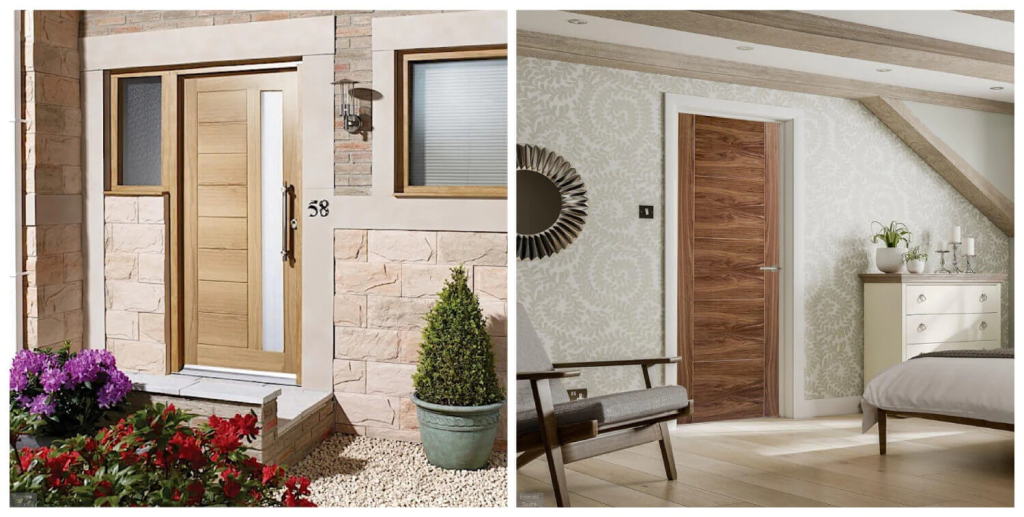
While most homeowners recognize exterior doors differ from interior models regarding durability, weatherizing, and security, significant additional variances exist affecting styles, sizes, operation, materials used, and costs. Reviewing the prime differences helps clarify appropriate product selections when replacing old doors.
Entry doors leading outdoors and patio doors granting backyard access share key commonalities separating them from standard interior doors installed in bedrooms, closets, and bathrooms not exposed directly to outdoor elements. Below is how numerous material, design, functional and pricing factors set interior and the exterior door into distinct categories.
Weatherizing And Insulation
Exterior doors feature weatherstripping gaskets, foam-filled cores, thermal breaks, and heavy-duty construction, preventing outdoor climate infiltration.
Insulation factors like U-Values rating heat flow resistance ensure energy efficiency and interior comfort despite sweltering summers or frigid winters. Interior doors require no weatherproofing at all.
Durability And Impact Resistance
Robust materials like fiberglass, steel, and solid wood make exterior entries more impact-resistant to protect against damaging dings, dents, and scratches from heavy use over decades. High foot traffic models withstand kids, pets, deliveries, and daily wear-and-tear without showing much aesthetic damage thanks to dent-defying density.
Most interior doors can only tolerate prolonged hard usage since cheaper lightweight materials like hollow cores, pressed wood, and weak veneers render them damage-prone.
Security Reinforcement
Exterior entries often integrate heavy-duty multi-point locks, four-screw hinges, elongated security strike plates, reinforced jambs, tempered glass, and tighter clearances impeding prying tools due to increased security risks posed by direct outdoor access.
Solid construction resists violent impacts from intruders. Interior doors feature only simple privacy locks that are easily overridden since valuables rarely get stored inside bedrooms that lack more security sensitivity.
Code Requirements
Regional building codes impose specific structural integrity mandates upon exterior entries, including fire ratings, impact-resistance certification, and forced entry prevention testing to comply with safety standards that interior door models completely exempt.
Standards establish reliable performance guidelines for windstorms, wildfires, and hazardous climate conditions exterior doors Toronto must withstand. Interior door codes only cover width allowances accommodating disabilities access and doorway clearances facilitating mobility.
Weather Exposure Impacts
Prolonged exposure to degrading door materials occurs outdoors from relentless UV radiation, humidity, rain precipitation, and extreme shifts between winter freezes and summer heatwaves only exterior entries face.
The manufacturing quality controls ensure stable integrity without damage over the years. Interior doors avoid weathering risks safely indoors away from the elements with durable, unchanging room climates.
Style Variations
Homeowners seeking stylish curb appeal tend to invest in specialized exterior door styles making distinctive visual statements, including decorative glass inserts, custom wood species stained in rich hues, luxury wrought iron finishes, or sleek modern aesthetics that interior doors inside the home rarely get viewed by visitors to appreciate intricate details.
Wider sizing availability also permits grandiose double-door exterior statement pieces showcasing intricate craftsmanship.
Improved Air Infiltration Protection
Advanced weatherstripping technology applied on today’s exterior entries establishes superior perimeter seals, keeping outdoor air from infiltrating indoors. Multi-point locks compress gaskets tightly while closed.
Low rates of air leakage prevent energy losses, improving insulation. Interior doors lack weather barriers since indoor air purity remains consistent from room to room, only requiring smoke seals to block fire from spreading through door cracks.
Operational Differences
Patio entries combining impressive glass exposure with smooth horizontal sliding mobility differ significantly from weighty swinging entry doors. Specialized pivot hinges allow heavyweight exterior pieces to open effortlessly despite wind gusts.
Interior door maneuverability is comparatively more straightforward without weather resistance factoring into ease of mobility. Standards only require indoor hardware properly latches to prevent accidentally swinging open rapidly.
Greater Size Availability
Exterior entries requiring broader points of entry are commonly available in larger dimensions, including double 3-6 doors, without the unique custom ordering that pricey interior jamb adjustments would necessitate.
Higher Costs And Values
Pricing on exterior doors averages two to ten times higher price tags than economy hollow core slab interior doors covering higher quality materials and durable protective finishes that prove critical facing outdoor exposure risks.
More excellent damage resistance holds future value, preventing early replacement. The customized nature of exterior entries also increases costs. Economy builder-grade interior doors value quickly but serve purposes fine inside homes at the lowest costs.